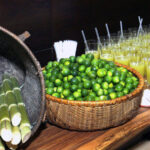When it comes to the renowned specialties of Dong Thap, the famous Lai Vung fermented pork sausage, or “nem Lai Vung” as it is locally known, is undoubtedly one of the most beloved dishes.
Nem Lai Vung has earned a prestigious reputation, being recognized among the top 10 most famous fermented pork sausages in Vietnam in 2012. Furthermore, in 2013, it was voted as one of the 50 best Vietnamese gifts and souvenirs. More recently, in 2020-2021, it secured its place in the top 100 specialties of the country, as announced by the Vietnam Records Organization.
Most notably, in November 2023, the “Art of Making Lai Vung Fermented Pork Sausage” was acknowledged as a National Intangible Cultural Heritage, underscoring its cultural and traditional significance in the Vietnamese culinary landscape.
Unlike many other types of fermented pork sausages found in other provinces, nem Lai Vung stands out with its distinctive features. It boasts a refreshing pinkish-red meat layer, skillfully wrapped in “lá vông” leaves (a local variety of leaves used for fermentation), and accented with black peppercorns and white garlic, resulting in an irresistible flavor profile.

Nem Lai Vung boasts a distinctive appearance with its pinkish-red meat layer, wrapped in “lá vông” leaves.
Each sausage is not just a mere delicacy but a delicate fusion of four fundamental tastes: salty, sweet, sour, and spicy. It captivates not only the taste buds but also the senses of smell and sight of those who indulge in it.
Ms. Ngoc Thuy, owner of a nem Lai Vung production facility in Lai Vung district, Dong Thap province, shared that the primary ingredients for making these sausages include pork, pork skin, “lá vông” leaves, garlic, chili, and black peppercorns.
Despite the familiarity and accessibility of these ingredients in the region, crafting delicious nem Lai Vung demands a meticulous and careful preparation process. This involves a series of steps, from sourcing and preprocessing the ingredients to mixing, fermenting, and ultimately packaging and preserving the sausages to maintain their freshness and flavor.
According to Ms. Thuy, the key to producing high-quality nem Lai Vung lies in the initial stages of ingredient preparation. The pork used must be fresh, sourced directly from the slaughterhouse, still warm, and possessing a certain elasticity. The ideal cuts of meat are from the hind thigh or lean rump, as these parts are notably tender and contain less connective tissue.

Fresh, warm pork with elasticity is essential for making high-quality nem Lai Vung.
Once the right pork is selected, it is then placed in a stone mortar and pounded to a fine consistency. The pork skin is boiled and finely shredded before being mixed with the meat. The ideal ratio is 8 parts meat to 2 parts skin, seasoned with a balanced blend of salt, sugar, black pepper, and monosodium glutamate.
Ms. Thuy revealed that while each family or sausage maker may have their own secret recipe and spice mix, the crucial aspect is to ensure the perfect harmony of the four fundamental tastes—sour, spicy, salty, and sweet—to captivate and satisfy all who taste it.
In contrast to many other fermented pork sausages that are typically wrapped in guava leaves, nem Lai Vung is distinctive in its use of “lá vông” or “lá chùm ruột” leaves. These leaves not only expedite the fermentation process but also impart a unique and delightful flavor to the final product.
To complete the packaging, the sausages are wrapped in “lá chuối xiêm” (a variety of banana leaf), known for its resilience, softness, and appealing color.

The sausages are wrapped in “lá chuối xiêm,” a resilient and visually appealing type of banana leaf.
Ms. Thuy shared that when placing the meat on the “lá vông” leaves, a pinch of black pepper and chili is added in the center, along with a slice of garlic on top. The art of wrapping the sausages requires dexterity to ensure that the meat does not spill out. This not only enhances the aesthetic appeal of the dish but also facilitates natural fermentation, resulting in a superb flavor experience.
Nem Lai Vung is crafted into small, square-shaped sausages, approximately the size of three fingers held together. Once prepared, they are tied into bunches of 10, with each bunch costing around 30,000 VND.
Many who have savored this specialty attest that nem Lai Vung can be enjoyed on its own or paired with vermicelli, bread, or rice crackers, creating unique and delightful flavor combinations.
The meat boasts a captivating pinkish-red hue, achieved through a natural fermentation process. The flavor profile strikes a perfect balance between tangy sourness, subtle sweetness, and a hint of spiciness from the garlic and black pepper, making it a favorite even among the most discerning palates.




































